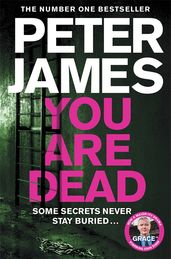Serial killers, Ted Bundy and interviewing murderers by Peter James
Peter James gives us an insight into how he gets into the mind of a serial killer and their motives when he's writing.

Peter James, author of the DSI Roy Grace series of crime novels, gives us an insight into his research process, and how he gets into the mindset of a serial killer and their motives.
We can understand the motives of many murderers. A loved one killed in a fit of jealous rage. A ruthless armed robber who shoots out of greed. The terrorist who kills out of warped ideology. The professional hit man who kills for a fee. The husband who buries his wife beneath the kitchen floor because he's fallen in love with someone else. But what about the serial killer?
It is the serial killer who intrigues and chills us all. The person who kills for sheer pleasure or satisfaction, the gratification derived from the act, driven by a mindset that is sometimes beyond comprehension, sometimes alien – and always repugnant to decent human beings.
As part of my research for You Are Dead, I studied a wide number of serial killers, both in the UK and the US, and in other countries too, trying to establish what common denominators, if any, there were. One of the nastiest, who has long fascinated me, was Dennis Rader. Between 1974 and 2001, he killed ten people, nine of them female, in and around Witchita, Kansas. This was a seemingly ordinary family man, a church warden, scout leader and local government compliance officer.
Ted Bundy is one of the true household names among serial killers. Good looking, charming, highly intelligent and charismatic, he studied Chinese followed by Law at university and worked for a period of time for the Republican party. Born in 1946, he was executed by electric chair in 1989, having confessed to murdering 39 young women, although the police believe his final tally was closer to 106. After a troubled middle-class upbringing, he was dumped by his first love, a teenager with long brown hair and a centre parting. Some months later he saw a similar looking young woman hitch-hiking, gave her a lift, and a short while later strangled her. “That made me feel good,” he told police, many years later after his arrest. He then went on a spree that was to last over a decade before his capture in 1975 and subsequent escape, and a further spree, before being recaptured in 1978.
I've talked to many murderers during my research for my this book and studied dozens of case histories. Among those I've interviewed was a woman who poisoned her mother-in-law, then her husband, to get their money; a man in Sussex who bludgeoned to death his father, stepfather and 10-year-old brother, also for money (he wanted make it look like a burglary gone wrong), and an armed robber who shot a bank worker dead. None showed any remorse, other than regret at having been caught and resentment at the length of their sentences.
In You are Dead, Roy Grace and his team have to come to terms with the fact that Brighton may have its first serial killer in over eighty years. In my research to create my central villain for this novel, I eventually singled out four names. These came from a catalogue, hundreds of pages long, of murderers who have taken three or more lives at different times – the actual definition of a serial killer. Ted Bundy. Dennis Rader. Harold Shipman. Dennis Nilsen. What fascinated me about these was how, outwardly, they seemed very respectable men. Shipman was a well-loved family doctor. Nilsen was in the army, then a police officer, then Executive Officer for a Jobcentre. All four of these got away with their killings over many years. Each of them very nearly got away with it completely.
You Are Dead
by Peter James
Is Detective Superintendent Roy Grace tracking his home city’s first serial killer in over eighty years?
A series of young women – all beautiful, all with long brown hair – have been stalked and abducted. Each victim is found with a brand on their body, a marking that reads ‘U R Dead’. And some of their remains are from thirty years ago.
When Logan Somerville is taken while on the phone to her fiancé, Grace must find a lead, connect the cases and track down the killer before they can strike again . . .
